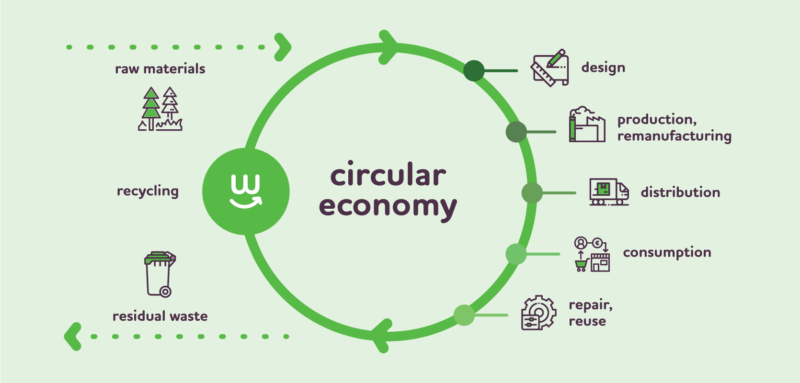Do you become more frequent by turning on the fan and going to the bathroom to wash yourself? This has become a common thing to experience because of climate change on Earth which is getting worse.
According to Climate.gov, the level of heat on Earth has risen 3x faster since 1982 by 0.36° F (0.20° C) per decade. Last year became the hottest year ever recorded since global records began in 1850.
One of the causes of the warming of the Earth’s temperature is the increase in carbon dioxide emissions, which are contributed by the world economic process that is still linear (take, make, discard).
To reduce these emissions, a circular economy has emerged which is predicted to be able to reduce emissions by up to 3.7 billion tons by 2050.
In this article, we invite you to understand more about the economy with sustainable standards that are also applied by BIOPAC.
Pengertian Circular Economy
Circular economy is a concept that carries the principle of waste reduction and maximum utilization of resources through recycling and reuse.
In contrast to the linear economic model of ‘take, make, discard’, the circular economy aims to create a closed cycle in which products, materials, and resources remain in the economic system for as long as possible.
The concept of the circular economy itself prioritizes the use of raw materials, semi-finished, and finished materials as much as possible (Reduce, Reuse, Recycle, Recovery and Repair.)
Within this framework, BIOPAC is present as a pioneer in creating environmentally friendly packaging innovations, committed to supporting sustainability and reducing negative impacts on the environment.
The Importance of Switching to a Circular Economy
The circular economy offers a range of significant benefits for the environment, the economy, and society as a whole. Here are some of the key benefits of implementing a circular economy:
- Waste Reduction
By adopting circular economy principles, waste generated by production and consumption processes can be significantly reduced.
Products are designed to last longer, be repaired, or recycled, reducing the amount of material that ends up in landfills.
- Natural Resource Saving
The circular economy prioritizes the reuse of materials and products, thereby reducing dependence on non-renewable natural resources. This helps maintain natural resource reserves and prevents their depletion.
- Increased Economic Efficiency
By maximizing the use of materials and energy, this economic system can reduce production and operating costs. The more efficient use of raw materials can also open up new economic opportunities, such as the recycling and repair industry.
- Job Creation
The transition to a circular economy can create new jobs in a variety of sectors, including the recycling, repair, and reuse industries. It also encourages innovation and the development of new technologies.
- Reduction of Carbon Emissions
By reducing the need to produce new items from raw materials and reducing waste disposal to landfills, the circular economy can contribute to reducing greenhouse gas emissions, helping to combat climate change.
- Economic Independence
By reducing dependence on imported raw materials through recycling and reuse, the circular economy can increase the economic independence of a country or region. It can also protect the economy from fluctuations in global raw material prices.
- Improved Quality of Life
By reducing pollution and extending the life of products, the circular economy contributes to improving the quality of the environment. This can have a positive impact on public health and overall quality of life.
- Encourage Innovation
The circular economy encourages companies to innovate in product design, manufacturing processes, and business models. This can pave the way for more efficient, durable, and environmentally friendly products.
The Role of BIOPAC Packaging in the Circular Economy
BIOPAC has developed a range of packaging products that are in line with the principles of the circular economy.
The raw materials used come from renewable resources, such as seaweed, which are not only biodegradable but also reduce dependence on conventional plastics.
Packaging products from BIOPAC itself have an edible grade for food and a biodegradable grade for non-food, so they are safe to consume and able to decompose naturally.
These packaging not only function as containers, but also play an important role in maintaining environmental sustainability.
The use of renewable raw materials helps reduce the carbon footprint, while the recyclable design ensures that the packaging does not end up in landfills, but returns to the production cycle.
BIOPAC with its eco-friendly packaging innovations is not only selling products, but also facilitating the transition to a circular economy.
By utilizing renewable raw materials and creating recyclable products, BIOPAC shows that sustainability can be achieved without sacrificing quality and functionality.
This concrete step is an example of how businesses can make a real contribution to creating a greener and more sustainable future.
Come on, join the movement towards a circular economy by choosing eco-friendly products from BIOPAC.
It’s not just about packaging choices, it’s about the commitment of all of us to preserving the planet for future generations.

